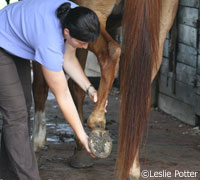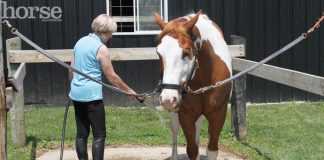
 Joint Mechanics
Joint Mechanics
So what are joints, and how do they work? Simply put, joints connect the ends of bones. Muscle contractions bend and flex the joints and facilitate movement of the skeleton—this creates locomotion. Your horse’s joints are able to absorb some of the concussion of leg impact, and their range of motion dictates the length of his stride.
Besides the intersecting bones, a joint is made up of many types of soft tissue structures, such as the cartilage that overlies the subchondral bone (that interfaces between the cartilage and the long bone); the dense connective tissue membrane that secretes lubricating synovial fluid; the capsule that wraps around the entire joint; and the supportive ligaments that surround each joint to maintain a safe degree of movement. A normal joint relies on its viscous layer of synovial fluid to cushion the cartilage and provide an easy, gliding motion.
As a rider, the areas that probably concern you most are the joints of your horse’s legs, as this is where trouble often lurks. Some leg joints, such as the pastern and hock joints, can only flex and extend, while others, such as the coffin joint, are able to manage a slight degree of rotation. Any time a horse bears weight on a leg, there is a risk of injury: he could set it down at a slightly twisted angle, step in a hole, or extend a leg too far in front of or behind himself when moving forward or sideways. In any of these cases, there may be stretching and strain of supportive soft tissue structures, impingement on cartilage, or overloading of the bone and/or cartilage of the joint. Any such tweak can set off a cycle of inflammation accompanied by pain, swelling and lameness, and end up interrupting your riding.
Preventive Care
The best joint health relies on prevention. Good conformation—straight legs without angular limb deformities (toeing in or out) or flexural contractions (club foot)—goes a long way toward minimizing the risk of joint injury.
Research has indicated that pasture turnout and exercise are critical for normal health in developing joints. If your next prospective equine partner is still young, don’t try to protect him by constraining him to a stall or small paddock; let him out to run, play and stretch his legs. The most critical time is within the first five months of life, as that is when the joints most rapidly and effectively develop to cope with the mild stresses of activity. As a foal grows and matures, careful conditioning strategies are also important to developing strong bones, joints, feet, ligaments and tendons. Care must be taken that any structured exercise is not too strenuous, particularly if there are already some orthopedic concerns. Since you may need to fine-tune this to your particular situation—breed, environment and athletic aspirations—discuss the best ways to accomplish conditioning with your veterinarian, whether you have a youngster or a more mature horse.
If a young horse has a conformational abnormality, such as toeing in or out, then stresses placed unevenly across the joints predispose them to injury. Successful treatment is based on rapid intervention. You should consult your veterinarian regularly during attempts to correct crooked legs through hoof trimming, diet and exercise. Surgical correction can be achieved in many cases, provided an angular limb deformity of the fetlock is addressed before 4 to 6 weeks of age and within three to six months if the crookedness originates at the level of the knee.
A more mature young horse that is beginning training should be evaluated by your veterinarian for conformational concerns. Any structural flaws pose a greater risk of joint injury and may determine the intensity of future training or the particular athletic path that poses the least risk.
Just as conformation is important, so too is hoof care: unlevel hoof balance can lead to abnormal stresses placed across a joint during exercise. Hoof balance is not always easy to see with the naked eye, so you should regularly examine the bottom of your horse’s feet (and shoes) for uneven wear that might be readily corrected with a balanced trim. If your horse is shod, nail heads may wear down differently on one side of a shoe than the other, or the bottom of the shoe may be thinner on one side due to greater impact and wear. Examine the coronet bands for symmetry, look at the position of the heel bulbs in relation to one another, and look for flares on the hoof walls—all of these are signs of improper hoof strike that can result from abnormal conformation and/or unlevel hoof balance.
Loading stresses are transmitted up the legs, with the most impact taken in the lowest joints, particularly the coffin joint. Implementing a strategy that ensures balanced trimming plays a significant role in joint health. Find the best farrier possible for your horse’s needs and schedule regular farrier visits. You and your farrier should consult with your veterinarian about any questions you may have.
The other element of joint health that is important for a young, growing horse is a balanced nutritional plan, conservative in calories and complete with balanced microminerals—especially calcium, phosphorus, copper and zinc—fed in appropriate amounts. One of the most common causes of developmental orthopedic disease (DOD) in young horses is overfeeding accompanied by rapid growth. Genetic tendencies (breed, conformation, growth speed) and environment (stabled vs. turned out) also contribute to DOD.
The take-home message for maximizing joint health is to consult with your veterinarian and/or an equine nutrition specialist about the best dietary choices for a growing horse. For a mature horse, good nutritional advice will help you avoid feeding excess calories, thereby preventing obesity, which overloads the musculoskeletal system.
Diagnosis of Joint Problems
Early recognition of a joint injury and rapid intervention is critical. With any acute onset of lameness, new swelling or tenderness, or when your horse doesn’t seem to be moving quite right, contact your veterinarian for a thorough lameness exam.
Historically, imaging techniques such as radiography (X-ray films) have been of great value in diagnosing the presence and extent of osteoarthritis. Nuclear scintigraphy has also been helpful in pinpointing an area of concern, while diagnostic ultrasound has been instrumental in identifying soft tissue lesions related to the joints. Magnetic resonance imaging (MRI) technology commonly used in human medicine has also recently become available to horses for use on the lower limbs. MRI studies have shown that a vast amount of pathology has gone unidentified with previously available imaging techniques. The MRI is now able to provide an accurate diagnosis as well as a prognosis for athletic soundness. With accurate definition of an injury, appropriate therapeutic choices can be made to facilitate healing.
Biomarker testing, another new technology, has promise for identification of early joint injury. This test relies on routine screening of blood samples to check for the presence and amount of biochemical indicators specific to cartilage disease. At this time there is no commercial test available, but efforts are being made to bring this to market.
Maintenance and Treatment Therapies
Many new joint medications have been introduced over the past 20 years or so, and the results of their use have been tracked with careful research as well as with anecdotal reports.
The systemic medications, such as intravenous hyaluronic acid (HA) and polysulfated glycosaminoglycans (GAGs), given both intramuscularly or directly into the joint (intra-articular, or IA), have been studied extensively for their therapeutic value. There is little doubt that both of these medications are effective in treating joints. They yield success when used as directed.
Oral HA has been suggested as a useful and easily administered medication for joint health, but there is still debate as to its efficacy. However, one study showed faster resolution of swelling among horses placed on oral HA after surgery for osteochondrosis of the hock than horses that were not treated.
Some new research has indicated there may be some value in preventive use of GAGs (both oral and intramuscular).
Oral joint supplements abound on the market, with claims of being able to maintain joint health. An important caution when using them is to have realistic expectations as to what they can achieve. There is no way to “repair” injured cartilage once it is damaged, so a horse with advanced degenerative arthritis is not likely to achieve much benefit along those lines from an oral supplement. However, products that have been tested through diligent research trials may be able to protect joint cartilage from future or further injury.
Keep Your Eye on the Prize
The objective is always to prevent injury whenever possible, since a joint with osteoarthritis will always remain an injured joint. Although an old injury may not be affected with inflammation at all times, it can flare up and create lameness, putting a horse out of work.
Take care in warming up your horse to allow soft tissues time to become elastic. Cool him down slowly and completely after a workout to facilitate dissipation of heat from all the tissues, not just the muscles. Ice the lower limbs and joints following rigorous exercise. Keep track of any swelling or change in appearance or comfort. Your attention to fine detail will go a long way toward keeping your horse’s joints mobile and comfortable.
Further Reading
HorseChannel’s Joint Care Guide
Nancy S. Loving, DVM, is a performance horse veterinarian based in Boulder, Colo., and is the author of All Horse Systems Go.
This article originally appeared in the December 2008 issue of Horse Illustrated. Click here to subscribe.





